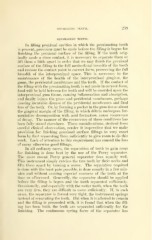Page 549 - My FlipBook
P. 549
SEPARATING TEETH. 250
SEPARATING TEETH.
In filling proximal cavities in which the proximating tooth
is present, provision must be made before the filling is begun for
finishing the proximal surface of the filling. If the teeth orig-
inally made a close contact, it is necessary to separate them or
lift them a little apart in order that we may finish the proximal
surface of the filling to the full mesio-distal breadth of the tooth
and restore the contact point in correct form, preserving the full
breadth of the interproximal space. This is necessary to the
maintenance of the health of the interproximal gingiva?, the
gTims, the peridental membranes and the teeth. If the contact of
the filling with the proximating tooth is not made in correct form,
food will be held between the teeth and will be crowded upon the
interproximal gum tissue, causing inflammation and absorption,
and finally injure the gums and peridental membranes, perhaps
causing incurable disease of the peridental membranes and final
loss of the teeth. Or, by forming a jjocket in the gum tissue about
the gingival margin of the filling, in which debris undergoes fer-
mentative decomposition with acid formation, cause recurrence
of decay. The manner of the recurrence of these conditions has
been fully stated elsewhere. These considerations, derived from
careful clinical observation, render it imperative that we make
provision for finishing proximal surface fillings to very exact
form by first separating them sufficiently to give room to do this
work. Lack of attention to this requirement has caused the loss
of many otherwise good fillings.
In all ordinary cases, the separation of teeth to gain room
for finishing is done best by the use of the Periy separator.
The more recent Perry general separator does equally well.
This instrument simply catches the two teeth by their necks and
lifts them apart by turning a screw. The separation required
is done with the least pain possible, is done usually in a few min-
utes and without causing especial soreness of the teeth at the
time or afterward. Generally, the separator should be applied
before the filling is begun and the teeth separated sufficiently.
Occasionally, and especially with the molar teeth, when the teeth
are very firm, they are difficult to move sufficiently. If, in such
cases, the separator is forced very tight, the instrument springs
instead of separating the teeth. But when it is allowed to remain
and the filling is proceeded with, it is found that when the fill-
ing has been built, the teeth are separated sivfficiently for the
finishing. The continuous spring force of the separator has


